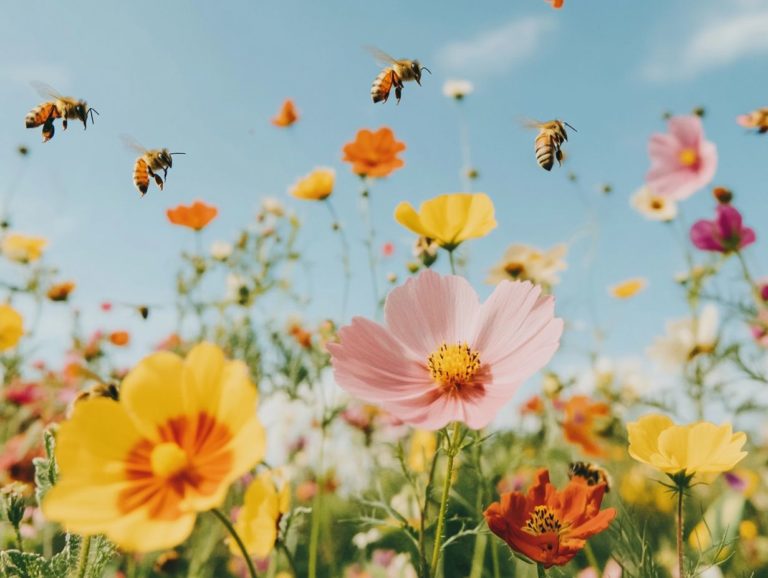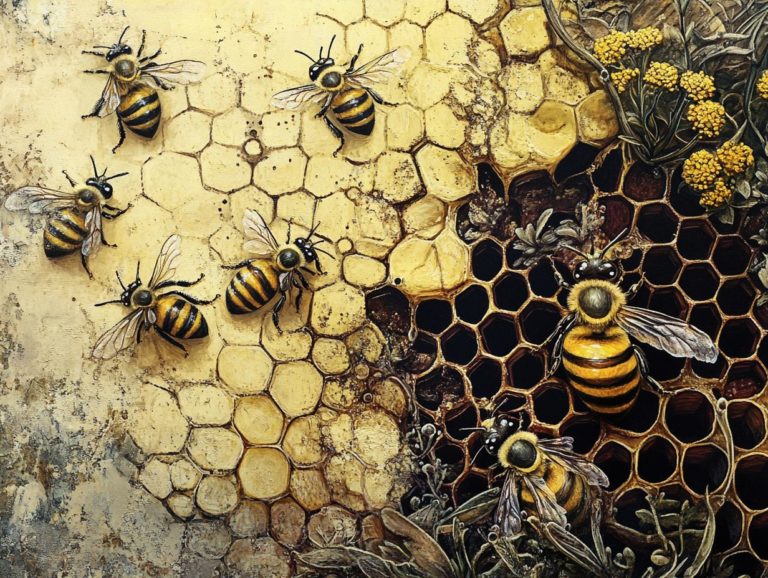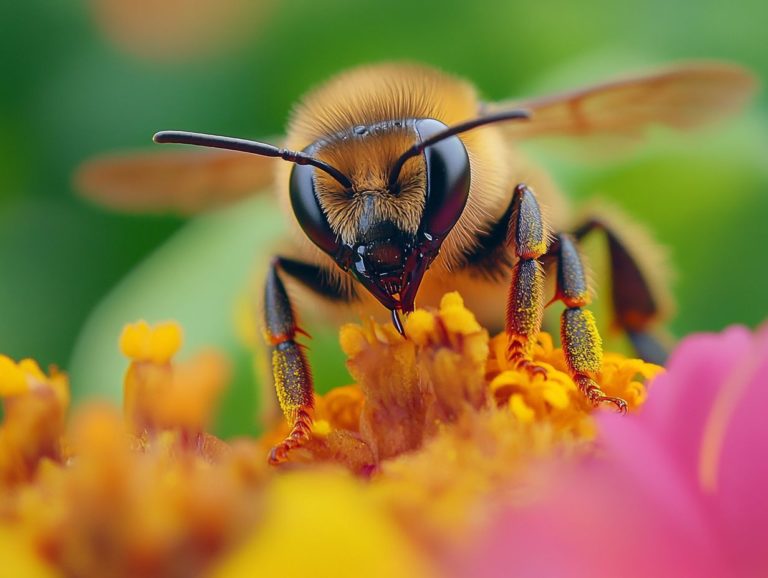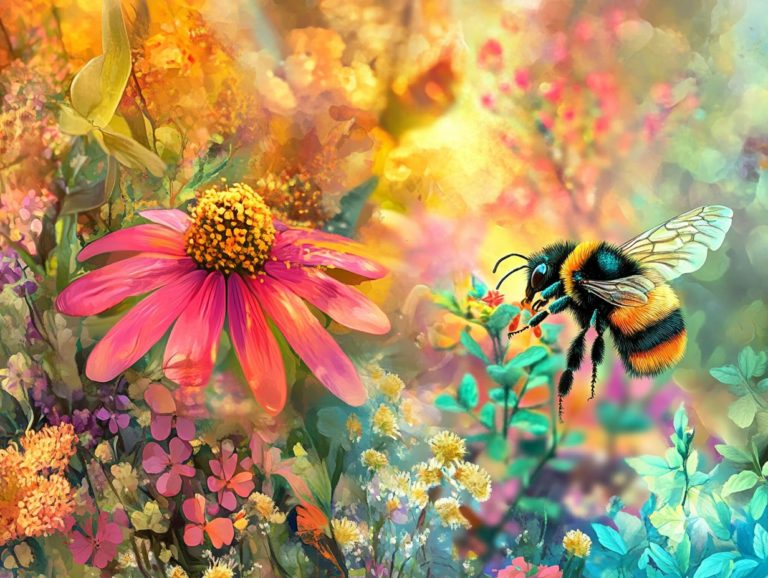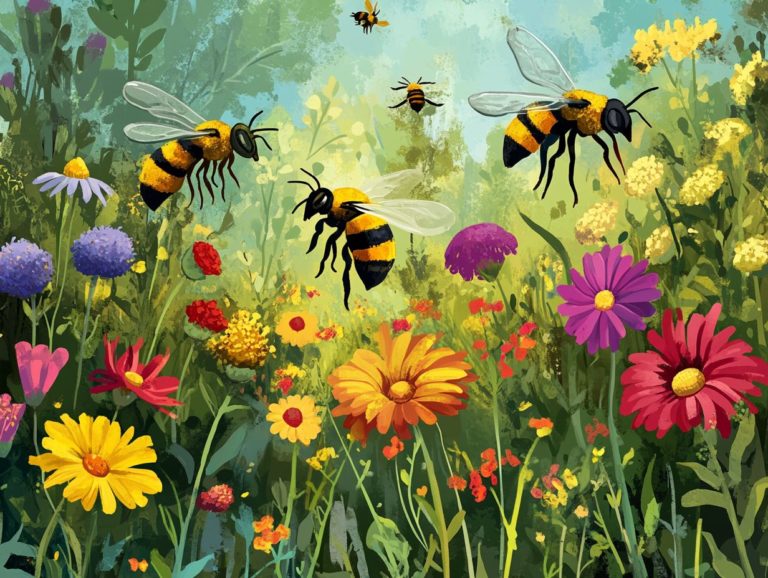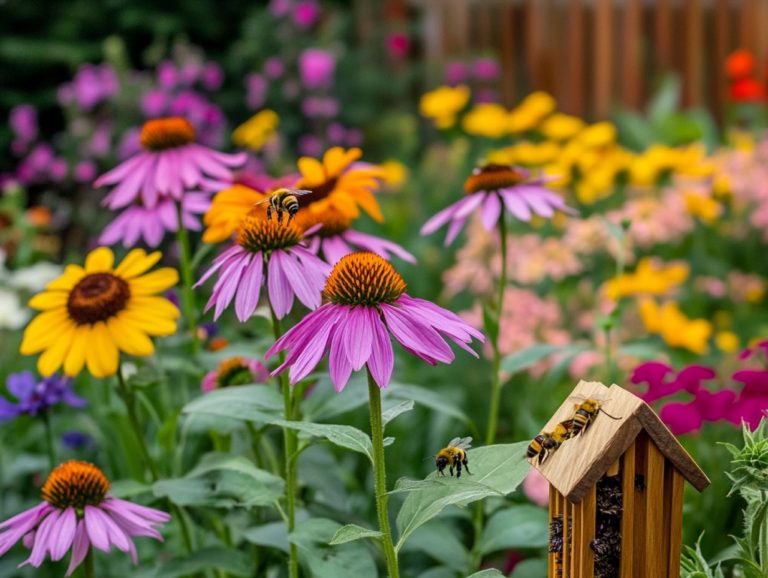How Bee Behavior Changes With Seasons
Honey bees hold an essential place in our ecosystem, and get ready to see a hive bursting with life as their behaviors shift dramatically with the changing seasons.
As early spring bursts into life, you ll uncover how honey bees adapt how they gather food, pollinate various plants throughout the year, and manage their hives in response to seasonal shifts. The quieter months of winter call for a more subdued approach.
Delve into the fascinating world of these tiny pollinators and see how they not only survive but thrive by attuning themselves to nature’s rhythms and seasonal patterns.
Contents
- Key Takeaways:
- How Do Bees Adapt to Seasons?
- How Do Seasons Affect Bee Pollination?
- How Do Seasons Affect Beehive Production?
- Frequently Asked Questions
- What is the relationship between bee behavior and seasonal patterns?
- How do bees behave in the spring?
- What changes in bee behavior can be observed during the summer?
- Do bees behave differently in the fall?
- How does the behavior of bees change in the winter?
- What Can We Learn from Observing Bee Behavior Changes with Seasons?
Key Takeaways:
- Bee behavior changes throughout the seasons to adapt to environmental changes and ensure the survival of the hive through every stage of the bee lifecycle.
- Different plants rely on bees for pollination during different seasons, highlighting the crucial role of bees in maintaining biodiversity and ecosystem balance.
- Bees have unique strategies for preparing for and surviving winter, including the behavior of winter bees while maintaining the hive and storing food for the upcoming season.
How Do Bees Adapt to Seasons?
Honey bees exhibit an impressive ability to adapt to the shifting seasons, a trait that profoundly affects their behavior and the overall health of the colony population. This adaptation impacts their hive activities as well.
As temperatures rise and fall and floral resources change throughout the year, these industrious insects modify their foraging habits and population dynamics to maximize nectar collection and ensure their survival during winter.
Recognizing these seasonal adaptations is essential for you if you’re involved in dealing with bee colonies. It also plays a vital role in addressing challenges like Varroa mites tiny parasites that attack bees mite infestations, and brood diseases that can threaten hive vitality at various times of the year.
What Changes in Bee Behavior Occur During Spring?
During early spring, you’ll notice honey bees undergoing remarkable behavioral changes, driven by the arrival of early-blooming flowers that bring a delightful increase in nectar flow and an abundance of pollen resources.
As the days warm up and stretch longer, the queen becomes more active, stepping up her egg-laying game to boost the colony s population. This surge in activity often leads to the creation of queen cells, indicating that the hive is thriving and ready to expand or swarm if needed. Queen rearing activities also become prominent during this period to ensure future hive leadership.
Simultaneously, the queen s pheromones play an essential role in fostering social cohesion, encouraging the worker bees to prioritize brood rearing. These coordinated efforts ensure a steady influx of new bees and enhance the colony s vitality, ultimately supporting peak honey production as they diligently gather resources during this pivotal seasonal period.
What Changes in Bee Behavior Occur During Summer?
In summer, honey bees kick their foraging efforts into high gear and expand their hives, taking full advantage of the abundance of floral resources to maximize honey production and boost their colony population.
The warm outdoor temperatures work wonders, significantly increasing the bees’ activity levels and encouraging them to journey further, spending more time collecting nectar from a variety of blooms. Worker bees are the unsung heroes of this bustling season, tirelessly gathering nectar and pollen to support their growing colony. As they flit from flower to flower, they also play a crucial role in pollination, essential for the health of the entire ecosystem.
Effective apiary management practices are now vital. As a beekeeper, you should keep a close eye on your hives for any signs of stress, ensure there s enough space for the expanding population, and stay alert for pests like varroa mites and potential diseases. By taking these proactive steps, you can promote healthy brood rearing and safeguard the productivity of your hives.
Dive deeper into the vibrant life of honey bees and discover how you can help preserve these essential pollinators!
How Fall Affects Bee Behavior
As fall approaches, honey bees gear up for their winter transition by adjusting their foraging habits and focusing on maximizing food storage during the autumn flow. Monitoring temperature thresholds during this period is critical for efficient preparation.
In anticipation of the cold months, these industrious little creatures become increasingly selective with their foraging. They concentrate on the remaining nectar-rich blooms, diligently storing honey and pollen to sustain themselves through winter. Implementing supplemental feeding strategies, like providing syrup or pollen substitute, can be beneficial during this period.
Understanding the challenges posed by dropping temperatures and dwindling floral resources, you can play a vital role as a beekeeper. Use supplemental feeding strategies to bolster the hive s food reserves, ensuring the colony remains active and healthy when natural sources begin to fade.
Bees exhibit remarkable colony defense mechanisms as well, clustering together to generate warmth while fiercely protecting their precious stores from pests and intruders during this vulnerable season.
How Winter Affects Bee Behavior
During winter, honey bees enter a fascinating state of reduced activity, relying on a tight cluster that helps them keep warm. Winter bees play a critical role during this period.
This remarkable adaptation sees the bees forming a tight mass within the hive, rotating positions so that those on the chilly outside can migrate inward to warm up. As winter approaches, these industrious insects meticulously manage their food reserves, consuming stored honey to fuel their metabolism and sustain the colony through the harsh months ahead. Monitoring the hive during this period is essential to prevent potential issues.
The importance of these overwintering bees cannot be overstated; they are essential for the hive’s continuity. Keeping a vigilant eye on their health during this time is paramount. Regular checks can prevent the havoc wreaked by pests like Varroa mites, which are harmful to bee colonies. Employ effective disease management strategies to safeguard the hive.
Use effective disease management practices, such as ensuring proper hive ventilation and minimizing moisture buildup. This is critical to guarantee the bees survive until spring, poised to pollinate and rejuvenate the environment. Hive monitoring throughout the winter is essential for successful overwintering.
How Do Seasons Affect Bee Pollination?
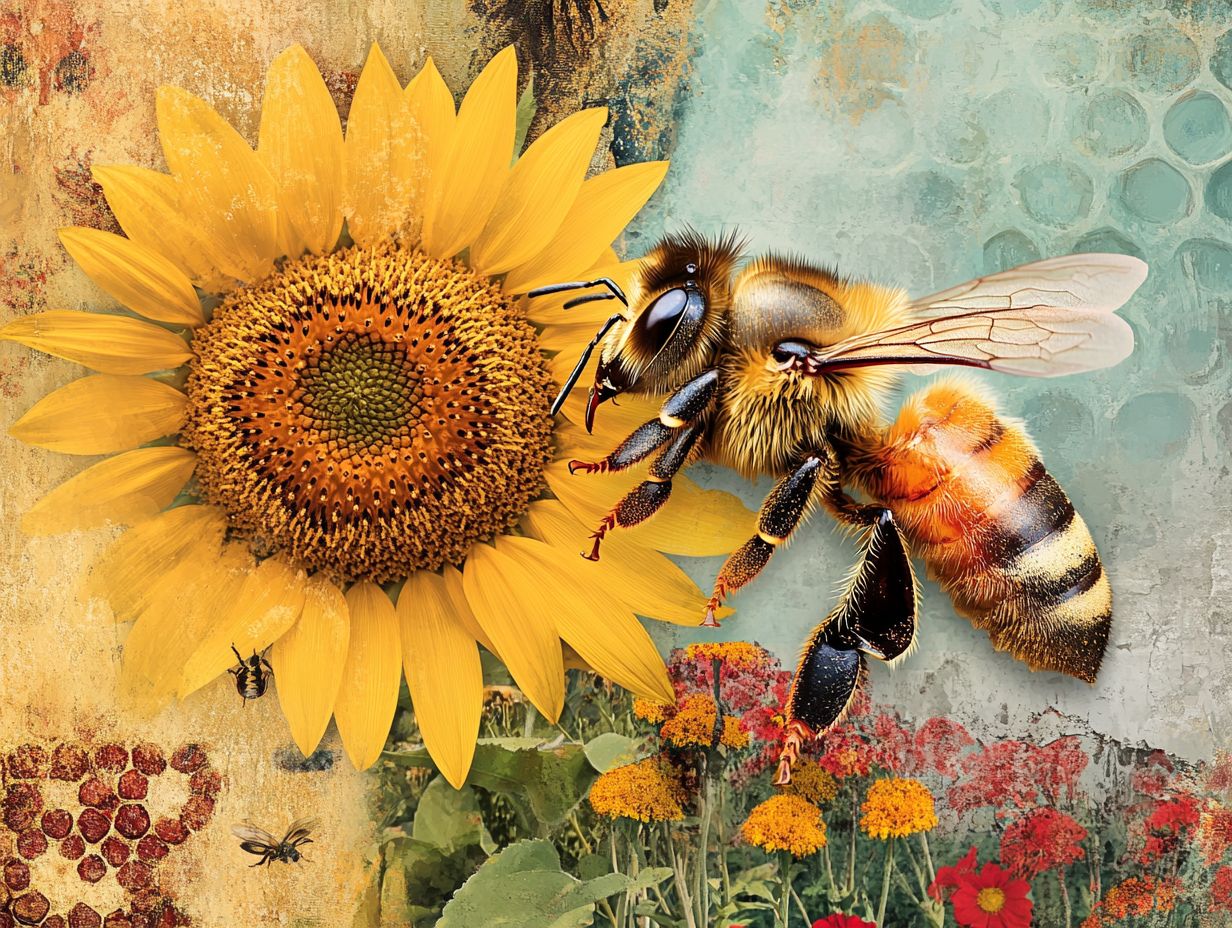
Seasonal transitions significantly influence honey bee pollination activities, directly linked to the availability of a variety of floral resources throughout the year. Recognizing seasonal behavior patterns is crucial for understanding these changes.
What Plants Do Bees Pollinate in Spring?
In early spring, honey bees focus on pollinating a delightful array of early-blooming plants, which offer vital nectar collection opportunities essential for the growth of their colony.
These flowering plants think crocuses, snowdrops, and cheerful early dandelions are crucial food sources, providing the carbohydrates that fuel their energy needs. As the queen releases pheromones throughout the hive, she sends a clear signal to the worker bees, urging them to embark on foraging excursions. This hormonal communication prompts the colony to venture out and gather these precious resources, ensuring that the queen and her brood receive the nutrition they require. Queen pheromone plays a pivotal role in this process.
These early blooms not only sustain the bees but also support the colony’s reproductive efforts, laying the foundation for a thriving hive as the season unfolds.
Join us in supporting bee health through responsible beekeeping!
What Plants Do Bees Pollinate in Summer?
During the summer months, you ll notice honey bees bustling about, actively pollinating a stunning array of vibrant blooms. Their industrious efforts play a significant role in honey production and the overall health of their colony lifecycle.
Among the many plants that charm these tireless pollinators are sunflowers, lavender, and clover. These blossoms draw in honey bees with their bright colors and sweet fragrances while serving a critical function in the ecosystem, offering sustenance for countless species. Effective honey harvesting practices can maximize the benefits of these plants.
The diligent foraging behavior of worker bees during this season is essential. As they gather pollen and nectar, they ensure that the hive stays robust and productive. This activity directly boosts honey yields!
Summer is a pivotal time for both bees and the flowering plants they cherish.
What Plants Do Bees Pollinate in Fall?
In the fall, you ll find honey bees busy pollinating late-blooming flowers, a vital endeavor that helps them gather enough food for the winter months. The fall flow is crucial for building reserves.
During this critical season, plants like goldenrod, asters, and sedum become essential resources as they provide a rich supply of nectar and pollen. These floral sources sustain the hive’s population and support honey production, serving as a natural energy reserve for the colder days ahead.
Environmental factors, such as temperature fluctuations and shifting weather patterns, can significantly influence the availability of these flowers. To adapt, many bees display impressive strategies, foraging on warmer days and seeking out the most abundant blooms. This maximizes their nectar collection, ensuring their colony is well-prepared for the harsh winter that looms. Effective beekeeping practices during this period can make a significant difference.
What Plants Do Bees Pollinate in Winter?
While winter may appear to be a dormant period for most plants, certain species provide limited resources that can be crucial for sustaining winter bee activity during the colder months.
Among the resilient winter bloomers are Hellebores, Winter Jasmine, and various types of Witch Hazel. Each offers vital nectar and pollen when few other sources are available. The presence of these flowers serves as a lifeline for foraging bees, enabling them to carry out their essential tasks even as outdoor temperatures drop.
Food availability often dwindles in winter, presenting significant challenges for colony populations. As a beekeeper, you can actively support your bees by providing supplemental feeding options. This ensures that your hives receive adequate nutrition, supporting overall colony health until early spring arrives with a richer tapestry of floral resources.
How Do Seasons Affect Beehive Production?
The production levels of a beehive are intricately tied to the rhythm of the changing seasons. Different phases of the bee lifecycle significantly affect honey production and the overall health of the colony, including critical periods like queen rearing and brood rearing.
Your understanding of these dynamics can elevate your beekeeping experience and enhance the vitality of your hives.
How Do Bees Prepare for Winter?
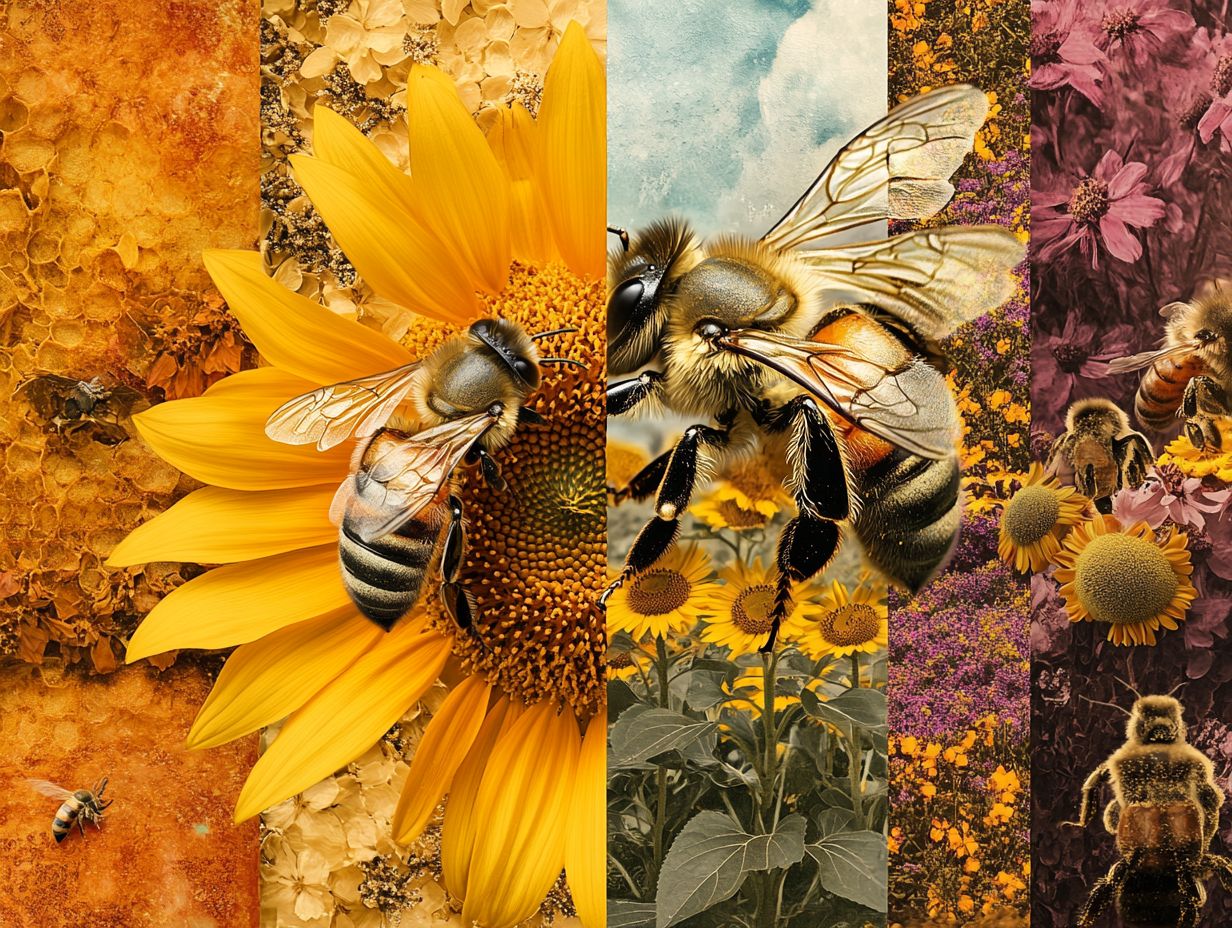
As winter approaches, honey bees engage in meticulous preparations to secure their survival. They prioritize food storage and form a heat-retaining group to keep the hive warm.
During this critical period, these industrious insects gather nectar from late-blooming flowers, transforming it into honey their primary food source.
When natural resources dwindle, they may rely on supplemental syrup and pollen substitute provided by beekeepers to boost their supplies. This careful foraging and storing is essential for the colony s survival through the harsh winter months. Without sufficient food stores, the risk of starvation looms large.
Proper apiary management during these times is crucial. Their collective effort to secure sustenance beautifully showcases the bees’ remarkable adaptability and resilience, ensuring that the hive remains robust until warmer temperatures return.
How Do Bees Survive Winter?
Honey bees navigate winter by forming a heat-retaining group. This fascinating strategy helps maintain the internal temperatures of the hive, allowing the colony to sustain itself even during periods of low activity.
This remarkable behavior is essential; the bees huddle together and vibrate their bodies to generate heat, ensuring that the queen remains safe and viable throughout the cold months.
As a beekeeper, it s crucial to monitor your hives regularly during this time. It s vital to ensure that food supplies are plentiful for the colony’s survival!
Checking for sufficient stores of honey and sugar syrup is key. Replenishing these supplies as needed can help prevent starvation.
Regular inspections help you detect and prevent diseases and pests such as Varroa mites that may threaten the health of the hive. By adopting these best practices, you can significantly enhance the likelihood of your colonies thriving until the warmth of spring returns.
How Do Bees Prepare for Spring?
As winter gracefully yields to spring, you ll notice honey bees springing into action, preparing for a vibrant new season filled with growth, increased hive activity, and the initiation of queen rearing.
During this pivotal transition, the colony buzzes with energy as temperatures rise and days stretch longer. The workers seize these favorable conditions, eagerly foraging for the first blooms that offer essential nectar and pollen.
As environmental factors like warmth and floral abundance improve, the bees engage in behaviors that boost brood production. This lays the groundwork for the colony’s success, which includes early blooming periods.
This seasonal renewal enhances their ability to expand and sharpens their resource-gathering efficiency, ultimately ensuring their survival and prosperity in the months to come.
How Do Bees Maintain the Hive During Summer?
During the summer months, you ll be amazed to see honey bees actively maintaining their hive, supporting the colony s lifecycle while ensuring optimal conditions for brood rearing and honey production.
These remarkable insects engage in various tasks, such as cleaning the hive to remove debris and pathogens. This crucial step prevents diseases that could jeopardize their survival.
Worker bees also repair any damaged cells in the honeycomb, often using propolis a resinous mixture they gather from tree buds and other sources to seal cracks and bolster structural integrity.
As temperatures and humidity levels fluctuate, you ll witness their ventilation efforts. They fan their wings to boost air circulation or cluster together to regulate warmth.
Collectively, these maintenance activities enhance the overall health of the colony, promoting resilience against environmental stressors and facilitating efficient honey production. Regular hive monitoring can help identify early signs of trouble.
How Do Bees Prepare for Fall?
As summer gracefully gives way to fall, you ll be amazed as honey bees shift their focus to prepare for winter. This phase is marked by an increase in nectar collection and careful food storage, often referred to as the fall flow.
During this crucial transition, the colony engages in vital activities, such as refining their honey reserves and managing hive populations through swarming techniques (the methods bees use to create new colonies). As a beekeeper, you hold a critical responsibility in monitoring these processes, ensuring that the bees have the necessary resources and a healthy environment to flourish. This includes effective swarm management and disease management practices.
This entails preparing safe, insulated hive spaces, checking for diseases, and supplementing food supplies whenever necessary. Proper food storage is crucial. It ensures that bees have enough reserves to survive the cold months ahead. Beekeepers must also be vigilant for signs of brood diseases like Chalkbrood and Sacbrood during this time.
By maintaining optimal conditions within the hive, you help prevent stress and foster a strong, resilient colony ready to thrive through winter’s challenges.
How Do Bees Store Food for Winter?
You might be fascinated to learn that honey bees are quite industrious when it comes to preparing for winter. They diligently collect nectar during the warmer months, transforming it into honey an essential energy source that sustains them through the cold season. Honey harvesting by beekeepers typically occurs during this period.
As they embark on this remarkable journey, bees assume a vital role in the ecosystem. They meticulously select nectar from a variety of flowers, returning to the hive with their precious cargo. Once inside, they expertly deposit the nectar into hexagonal beeswax cells, where they fan it with their wings to evaporate excess moisture, thickening it into the golden honey we admire. This process also includes the creation of queen cells for future queens.
This intricate process not only secures the food reserves necessary for their survival but also underscores their critical importance in pollination.
Beekeepers may face challenges during seasons of low nectar flow, such as late summer or autumn flow, where natural food sources fall short. To support their colonies, they can introduce supplemental feeding methods like sugar syrup or pollen patties, which provide the essential nutrients and energy needed to help the colonies thrive even in difficult times.
Frequently Asked Questions
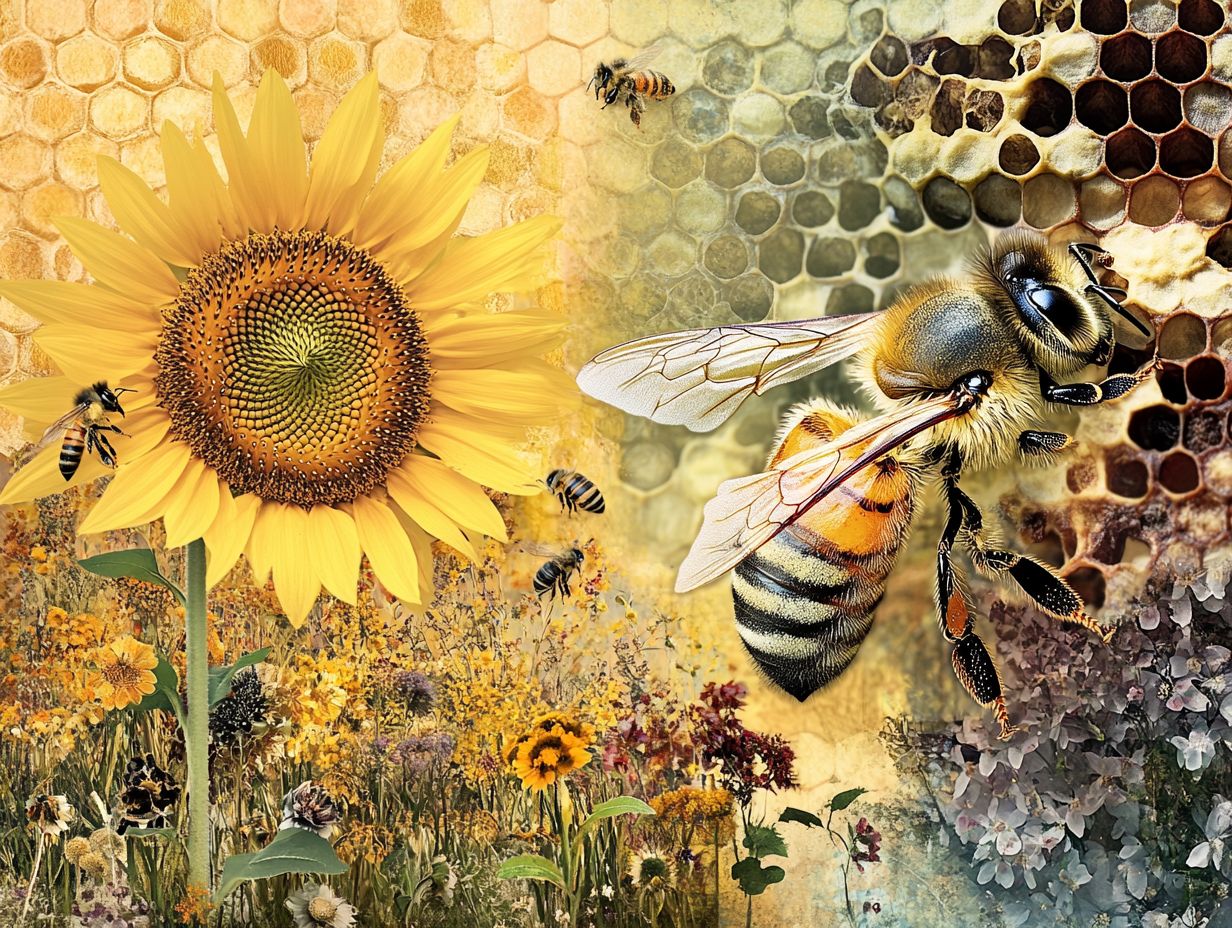
What is the relationship between bee behavior and seasonal patterns?
The behavior of bees is greatly impacted by the changing seasons. As the weather, availability of resources, and the needs of the hive change throughout the year, bees adapt their behavior accordingly.
How do bees behave in the spring?
In the spring, bees are busy collecting pollen and nectar to rebuild their colony after the winter. They also begin the process of reproducing by creating new queens and drones, stimulated by the queen pheromone.
What changes in bee behavior can be observed during the summer?
During the summer, bees continue to collect nectar and pollen, but their main focus shifts to filling the hive with food for the winter. They also become more defensive of their hive as resources become scarce and predators become more active.
Do bees behave differently in the fall?
In the fall, bee behavior changes as they prepare for the colder months ahead. They begin to slow down their activity and start to cluster together in the hive to keep warm. They also reduce the number of drones in the colony, as they are no longer needed for reproduction, a common swarming behavior.
How does the behavior of bees change in the winter?
In the winter, bees, often referred to as winter bees, enter a state of dormancy. They huddle together in the hive to conserve warmth and rely on stored food to survive, true to their thermoregulating cluster behavior. Bees will only leave the hive on warmer days to eliminate waste and gather water, demonstrating their natural adaptability.
What Can We Learn from Observing Bee Behavior Changes with Seasons?
Studying how bees adapt to seasonal changes helps us understand their survival. This knowledge is essential for protecting and supporting bee populations.
Bees play a critical role in pollination, which is vital for our ecosystems. Researchers like Mehmet Ali D ke, Maryann Frazier, and Christina M Grozinger from Penn State, along with the Grozinger Lab and Center for Pollinator Research, provide valuable insights into these dynamics.

